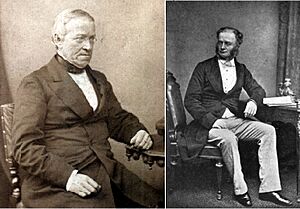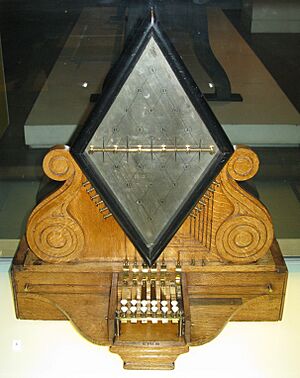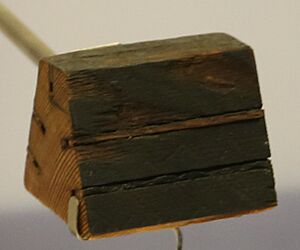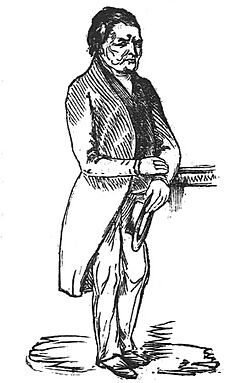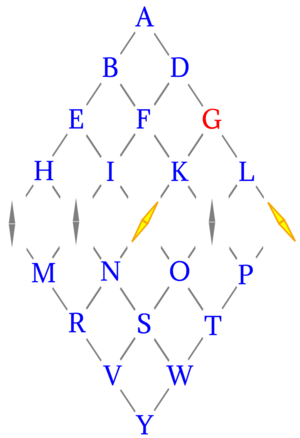Cooke and Wheatstone telegraph facts for kids
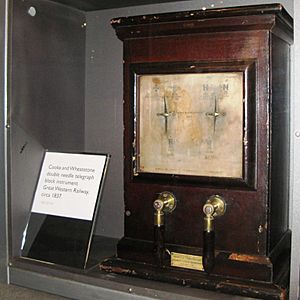
The Cooke and Wheatstone telegraph was an early way to send messages using electricity. It was invented in the 1830s by two English gentlemen, William Fothergill Cooke and Charles Wheatstone. This system used special needles that moved to show letters on a board. It was the very first telegraph system used for businesses and the public. People liked it because they didn't have to learn a secret code to read the messages.
Later versions of this telegraph used fewer needles. This meant the messages had to be read using a code, not just by looking at letters on a board. This change happened because it was expensive to use many wires, and some of the early wires stopped working well. Cooke and Wheatstone's most successful design used only one needle and was used for a very long time, even into the 1930s!
This telegraph system became famous when it helped catch a person suspected of a crime, John Tawell. When it was known that Tawell was on a train to London, the telegraph sent a message ahead to the station. This allowed him to be arrested when he arrived. This exciting use of the telegraph made many people interested in this new technology.
Contents
Who Invented This Amazing Device?
The telegraph was created by William Fothergill Cooke and Charles Wheatstone. You might know Wheatstone from the Wheatstone bridge in science class! Cooke was an inventor and wanted to sell his inventions. Wheatstone was a scientist who preferred to share his discoveries freely. These different ideas led to some disagreements between them. Eventually, Cooke bought Wheatstone's share of the invention.
Cooke had some ideas for a telegraph before working with Wheatstone. He even asked scientist Michael Faraday for advice. But much of the scientific knowledge that made their telegraph work came from Wheatstone.
How the Telegraph Changed History
In 1837, Cooke suggested a mechanical telegraph system to a railway company. They needed a simple way to send signals between a station and an engine house. This was important for pulling trains up steep hills. Cooke made a simpler version, but the railway chose a system that used air and whistles instead. Soon after, Cooke teamed up with Wheatstone.
In May 1837, Cooke and Wheatstone patented their needle telegraph. It could use many needles to point to letters. They showed a four-needle system on a railway line in London. This was also for signaling engine houses. But again, the railway chose a system with whistles.
Their first big success came in 1838 on the Great Western Railway. They installed a telegraph over 13 kilometers (about 8 miles) from Paddington station to West Drayton. This was the world's first commercial telegraph! It used five needles and six wires. The wires were first buried underground, but the insulation failed. So, they used a two-needle system with fewer working wires. This new system needed operators to learn a code, making them the first skilled telegraph operators.
In 1843, the line was extended, and a simpler one-needle, two-wire system was installed. Cooke also started hanging wires on poles with ceramic insulators, which was cheaper and easier to fix. This method quickly became very common. Cooke also made a deal that allowed him to open public telegraph offices. This meant anyone could send a telegram for the first time! It cost one shilling, and many people paid just to see the amazing new equipment.
The electric telegraph then started to grow quickly on new railways. Many lines, like the London and Blackwall Railway, began using it. In 1845, a much longer line (88 miles) was built. The British Navy used a private telegraph on this line to connect to its base in Portsmouth. This finally replaced their old system of sending signals with flags or lights. In 1845, a company called the Electric Telegraph Company was formed. This company bought the patents and helped the telegraph business grow. Later, in 1869, the government took over the company. The one-needle telegraph was very popular on British railways, with 15,000 sets still in use at the end of the 1800s. Some even lasted until the 1930s!
The Cooke and Wheatstone telegraph was mostly used in the United Kingdom. However, it was also used in Spain for a while. After the telegraph companies became part of the government, other systems, like the Morse telegraph, slowly replaced the Cooke and Wheatstone telegraph.
Catching a Suspect with Telegraphy
On January 1, 1845, a person suspected of a crime, John Tawell, was caught thanks to a telegraph message. This was likely the first time a telegraph was used to help catch a suspect! The message sent from Slough to Paddington said:
A MURDER HAS GUST BEEN COMMITTED AT SALT HILL AND THE SUSPECTED MURDERER WAS SEEN TO TAKE A FIRST CLASS TICKET TO LONDON BY THE TRAIN WHICH LEFT SLOUGH AT 742 PM HE IS IN THE GARB OF A KWAKER WITH A GREAT COAT ON WHICH REACHES NEARLY DOWN TO HIS FEET HE IS IN THE LAST COMPARTMENT OF THE SECOND CLASS COMPARTMENT
The Cooke and Wheatstone system didn't have punctuation, lowercase letters, or some letters like J, Q, and Z. That's why "just" was spelled "GUST" and "Quaker" was "KWAKER." The operator at Paddington was confused at first, but eventually, the message was understood. When Tawell arrived, a detective followed him and arrested him. Newspapers shared this exciting story, making the electric telegraph very famous and showing everyone how useful it could be.
This event, along with the telegraph's announcement of the birth of Prince Alfred, Queen Victoria's second son, helped the telegraph become widely used beyond just railway signals. The news of the birth was published in The Times newspaper just 40 minutes after it happened, which was incredibly fast for that time!
Making Railways Safer
The signalling block system is a safety method for trains. It divides a railway track into sections called "blocks." Signals prevent a second train from entering a block until the first train has left it. Cooke suggested this system in 1842 to make single-line railways safer. Before this, train safety relied only on strict schedules, which couldn't handle unexpected problems.
The first use of this block system was probably in 1839 with a Cooke and Wheatstone telegraph in a tunnel. Special instruments for block working were installed in 1841. This system became the standard for railways and is still used today. Modern technology has even improved it, allowing for "moving blocks" on busy lines.
How Did the Telegraph Work?
The Cooke and Wheatstone telegraph used magnetic needles. These needles could turn a little bit, either clockwise or counter-clockwise. This movement happened because of electricity flowing through coils of wire. The direction the needle moved depended on the direction of the electric current. The telegraph board had a diamond-shaped grid with letters at each crossing point. When two needles moved, they would point to a specific letter.
The number of wires needed for the system was the same as the number of needles. Cooke and Wheatstone's first patent suggested five needles. Here's how many different signals could be made with different numbers of needles:
| Number of needles | Possible signals |
|---|---|
| 2 | 2 |
| 3 | 6 |
| 4 | 12 |
| 5 | 20 |
| 6 | 30 |
| 7 | 42 |
| 8 | 56 |
| 9 | 72 |
| 10 | 90 |
To send a message, the operator pressed buttons. This sent electricity through two of the wires. At the other end, the same two needles would move, pointing to the letter being sent. The needles always moved in pairs and in opposite directions.
Sending Messages with Needles
The five-needle telegraph could show 20 different letters or symbols. It was missing a few letters like C, J, Q, U, X, and Z. A great thing about this telegraph was how easy it was to use. Operators didn't need to learn a complex code because the letter appeared right on the board for everyone to see.
Later, they found a way to move just one needle at a time. This needed an extra wire. This change allowed for many more codes. However, using these new codes meant operators had to learn them, as they couldn't just read them from the grid. So, this extra feature was mainly used to add numbers, which were marked around the edge of the board. But because it was expensive to use many wires, Cooke and Wheatstone eventually created simpler two-needle and one-needle telegraphs.
Different Types of Needle Telegraphs
The Two-Needle System
The two-needle telegraph used three wires: one for each needle and a shared return wire. This system used a code that operators had to learn. The needles could move left or right, one, two, or three times quickly. They could also move in both directions quickly. This allowed for 24 different codes. Three letters (J, Q, and Z) were left out and replaced with G, K, and S.
This telegraph originally had a bell to get the operator's attention. But the bell was so loud and annoying that they removed it! It turned out that the clicking sound of the needle hitting its stop was enough to get attention.
The One-Needle System
This system was made to replace the older, failing telegraph on the Paddington to West Drayton line. It only needed two wires but used a more complex code and sent messages slower. While the two-needle system used a three-movement code for each letter, the one-needle system used a four-movement code. This was enough to send every letter of the alphabet. Like the two-needle system, the code involved quick movements of the needle to the left or right. The needle would hit a post when it moved, making a sound. The sounds for left and right movements were different, so operators could "hear" the message without always looking at the needle.
The Telegraph's Impact and Legacy
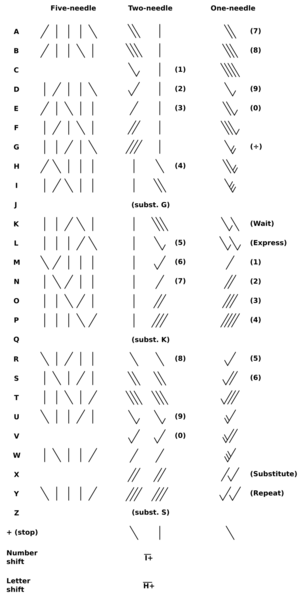
Over time, the codes for these telegraphs were improved. By 1867, numbers were added to the five-needle code. This was done by adding a sixth wire, which allowed a single needle to move. With the original five wires, needles always moved in pairs and opposite directions. The numbers 1 through 5 were shown by needles 1 through 5 pointing right. Numbers 6 through 9 and 0 were shown by them pointing left.
Later, codes for Q (![]() ) and Z (
) and Z (![]() ) were added to the one-needle code, and eventually for J (
) were added to the one-needle code, and eventually for J (![]() ) too. There were also special codes for things like "number shift" (
) too. There were also special codes for things like "number shift" (![]() ) and "letter shift" (
) and "letter shift" (![]() ), which let operators switch between sending numbers and letters. Many other special codes were added for operator commands, like "wait" or "repeat."
), which let operators switch between sending numbers and letters. Many other special codes were added for operator commands, like "wait" or "repeat."
Images for kids


